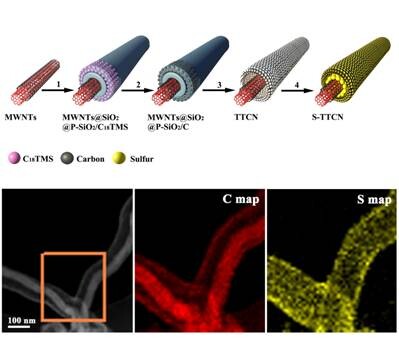
Researchers Report Tube-in-Tube Carbon Nanostructure for Lithium-Sulfur Batteries
Jun 19, 2014 Email"> PrintText Size

Lithium-sulfur (Li-S) batteries have attracted a great deal of attention due to its high theoretical capacity and energy density, which is 3-5 times higher than that of commercial lithium-ion batteries. In addition, sulfur is inexpensive, environmental benign, and abundant on earth, making it one of the most promising candidates for next-generation high energy batteries.
However, hampered by the poor electrical conductivity, dissolution of lithium polysulfide, and volume expansion of sulfur during cycles, the commercial application of Li-S batteries are still far away. To solve these problems, the rational design and synthesis of porous carbon nanomaterials for encapsulating sulfur has been proved to effectively enhance the electrochemical performance of Li-S batteries.
The research group headed by Prof. GUAN Lunhui at Fujian Institute of Research on the Structure of Matter, Chinese Academy of Science, has designed and synthesized a tube-in-tube carbon nanostructure (TTCN), in which multi-walled carbon nanotubes (MWNTs) were encapsulated within hollow porous carbon nanotubes.
Such a design benefits Li-S batteries through three aspects: The MWNTs and outer porous carbon nanotube provide high electrical conductivity; the large internal void enables a high sulfur loading and accommodates volume expansion; the outer porous tube wall inhibits the polysulfide dissolution. Thus, as-synthesized TTCN (with 71 wt% sulfur) cathode exhibited outstanding electrochemical performance with high specific capacity, superior cycling retention and excellent rate performance.
Furthermore, this work provides a general strategy to synthesize superior hybrid carbons with large void space, which is crucial to improve the energy density and electrochemical performance of Li-S batteries. Results of this study have been published as a communication in Adv. Mater., DOI: 10.1002/adma.201401191.

Schematic illustration and element mappings for the sulfur encapsulated within tube-in-tube carbon nanostructure (Image by Prof. GUAN Lunhui’s group)
Lithium-sulfur (Li-S) batteries have attracted a great deal of attention due to its high theoretical capacity and energy density, which is 3-5 times higher than that of commercial lithium-ion batteries. In addition, sulfur is inexpensive, environmental benign, and abundant on earth, making it one of the most promising candidates for next-generation high energy batteries.
However, hampered by the poor electrical conductivity, dissolution of lithium polysulfide, and volume expansion of sulfur during cycles, the commercial application of Li-S batteries are still far away. To solve these problems, the rational design and synthesis of porous carbon nanomaterials for encapsulating sulfur has been proved to effectively enhance the electrochemical performance of Li-S batteries.
The research group headed by Prof. GUAN Lunhui at Fujian Institute of Research on the Structure of Matter, Chinese Academy of Science, has designed and synthesized a tube-in-tube carbon nanostructure (TTCN), in which multi-walled carbon nanotubes (MWNTs) were encapsulated within hollow porous carbon nanotubes.
Such a design benefits Li-S batteries through three aspects: The MWNTs and outer porous carbon nanotube provide high electrical conductivity; the large internal void enables a high sulfur loading and accommodates volume expansion; the outer porous tube wall inhibits the polysulfide dissolution. Thus, as-synthesized TTCN (with 71 wt% sulfur) cathode exhibited outstanding electrochemical performance with high specific capacity, superior cycling retention and excellent rate performance.
Furthermore, this work provides a general strategy to synthesize superior hybrid carbons with large void space, which is crucial to improve the energy density and electrochemical performance of Li-S batteries. Results of this study have been published as a communication in Adv. Mater., DOI: 10.1002/adma.201401191.

Schematic illustration and element mappings for the sulfur encapsulated within tube-in-tube carbon nanostructure (Image by Prof. GUAN Lunhui’s group)
CAS Institutes
There are 124 Institutions directly under the CAS by the end of 2012, with 104 research institutes, five universities & supporting organizations, 12 management organizations that consist of the headquarters and branches, and three other units. Moreover, there are 25 legal entities affiliated and 22 CAS invested holding enterprisesThere are 124 I...>> more
Contact Us

Chinese Academy of Sciences
Add: 52 Sanlihe Rd., Xicheng District, Beijing, China
Postcode: 100864
Tel: 86-10-68597592 (day) 86-10-68597289 (night)
Fax: 86-10-68511095 (day) 86-10-68512458 (night)
E-mail: cas_en@cas.cn

